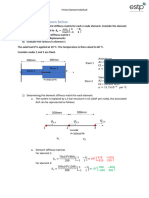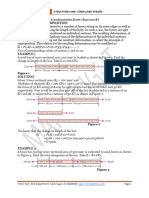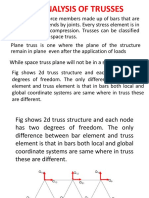Introduction To Finite Element Techniques - Tutorial 2
Uploaded by
anthonyIntroduction To Finite Element Techniques - Tutorial 2
Uploaded by
anthonyA4 FE Techniques
Introduction to Finite Element Techniques – Tutorial 2
These questions involve the use of element stiffness matrices and their assembly to solve a
number of structural problems.
1. A surveyor’s steel tape 30 m long has a cross-section of 6 mm by 1 mm. Determine
the elongation when the entire tape is stretched and held taut by a force of 50 N. The
modulus of elasticity is 200 x 109 N/m2.
[Hint: Use element stiffness matrix for a bar]
[Ans: Elongation = 1.25 mm]
2. A solid circular steel rod 6 mm in diameter and 500 mm long is fastened to the end of
a square brass bar 25 mm on a side and 400 mm long, the geometric axes of the
bars lying along the same line. One end of the bar is held fixed and an axial tensile
force of 5 kN is applied at the other end. Determine the total elongation of the
assembly. For steel, E= 200 x 109 N/m2 and for brass, 90 x 109 N/m2
[Hint: Derive the element stiffness matrix for each bar and obtain the global stiffness
matrix as in the notes]
[Ans: Elongation = 0.477 mm].
3. A steel bar of cross-section 500 mm2 is acted upon by the forces as shown below.
Determine the total elongation of the bar. For steel, E= 200 x 109 N/m2
Obtain the global stiffness matrix, and confirm that the solution u1 = 0; u2 = 0.25mm;
u3 = 0.6mm; u4 = 1.275mm satisfies the equilibrium equations.
[Hint: This time, three element stiffness matrices need to be derived and assembled]
Page 1 of 1
You might also like
- Modeling and Analysis Lab Problems and Solution (17MEL68)100% (1)Modeling and Analysis Lab Problems and Solution (17MEL68)747 pages
- Department of Civil Engineering, Iit Bombay: Tutorial Sheet 2No ratings yetDepartment of Civil Engineering, Iit Bombay: Tutorial Sheet 26 pages
- ACTIVITY 1 - Custodio, Permelona, Santos John PaulNo ratings yetACTIVITY 1 - Custodio, Permelona, Santos John Paul6 pages
- Mechanics of Deformable Bodies Quiz 2 May 19, 2020: CE 323/ BES 222100% (1)Mechanics of Deformable Bodies Quiz 2 May 19, 2020: CE 323/ BES 2222 pages
- Statically Indeterminate Members: Indeterminate. These Cases Require The Use of Additional Relations That Depend On TheNo ratings yetStatically Indeterminate Members: Indeterminate. These Cases Require The Use of Additional Relations That Depend On The26 pages
- KKKH3353 - Structural Steel Design - Tension Members100% (2)KKKH3353 - Structural Steel Design - Tension Members21 pages
- Exercise 1. Find Element and Global Stiffness For The Following Spring. A)No ratings yetExercise 1. Find Element and Global Stiffness For The Following Spring. A)5 pages
- C.K. Pithawala College of Engg. and Technology: Gujarat Technical UniversityNo ratings yetC.K. Pithawala College of Engg. and Technology: Gujarat Technical University27 pages
- A circular rod of diameter 20mm and 500mm long is subjected to a tensile force of 45kNNo ratings yetA circular rod of diameter 20mm and 500mm long is subjected to a tensile force of 45kN32 pages
- Finite Element Analysis 17ME61 Module 2No ratings yetFinite Element Analysis 17ME61 Module 249 pages
- Unit - Ii One Dimensional Problems Part - ANo ratings yetUnit - Ii One Dimensional Problems Part - A29 pages
- EDWARD ZAMBRANO VALER - Tarea 01-IC252BCINo ratings yetEDWARD ZAMBRANO VALER - Tarea 01-IC252BCI9 pages
- Ce383 Structural Analysis: Area 2500 MM E 60000 Mpa For All MembersNo ratings yetCe383 Structural Analysis: Area 2500 MM E 60000 Mpa For All Members5 pages
- Dhore - Unit I Simple Stresses and Strains Part-IV - Vishal DhoreNo ratings yetDhore - Unit I Simple Stresses and Strains Part-IV - Vishal Dhore22 pages
- Hyderabad Campus FIRST SEMESTER 2015-2016: (08 Marks)No ratings yetHyderabad Campus FIRST SEMESTER 2015-2016: (08 Marks)3 pages
- Chapter Four Anaysis of Truss StructureNo ratings yetChapter Four Anaysis of Truss Structure24 pages



























































